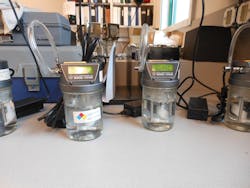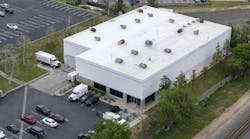In a not too distant past, paper played a large role in operations at the Idaho State Police Forensic Services (ISPFS) lab. During a tour, I had the opportunity to learn that over the last 15 years, the lab has made investments in technology including an information management system, instruments to automate and speed the DNA process, equipment to calibrate breathalyzers, digitization of fingerprint analysis and much more. ISPFS has also turned itself into one of the most transparent laboratory systems in the U.S. by making its data available on its website and web portals.
Since the transition into tech, the lab has been able to complete work with greater speed and efficiency—it has seen decreased turnaround times and more cases worked.
Advancements in DNA
When a police officer enters Meridian, Idaho-based ISPFS, they approach a window where they can drop off their evidence for testing. The evidence was pre-logged in the web-based system by the officer or agency evidence technician before they arrive at the crime lab. The system is called the Idaho Laboratory Information Management System (ILIMS), software customized for the lab from Porter Lee’s Crime Fighter BEAST, an integrated evidence tracking system which has allowed the lab to record and track case related information from item and sample information to report generation and more.
The initial investment, reports Matthew Gamette, ISPFS’ director of forensic services, was several hundred thousand dollars (significant for a small lab system), but has saved time and money and created efficiencies. The system allows the LEO to track the case progress in real-time through the laboratory process and electronically get access to the reports and analyst case notes immediately after they are signed by the laboratory analyst. “Everything used to be on paper, but there was a huge transition in our lab as we integrated technology,” says Gamette.
We walk further back into the laboratory where Gamette explains that there are multiple instruments involved in the DNA process. Each of them has made getting the results quicker over the years, despite the price tag of the instruments, which range from $30,000 to over $200,000.
Due to backlogs and increased demand for DNA analysis, it can take weeks, months, even a year or more to get the DNA results back to law enforcement, Gamette says, but new technologies being implemented around the country can take a day or less to get DNA results for some types of samples. Rapid DNA technology, while not currently being used by the ISPFS, could eventually be crucial for law enforcement, especially in booking stations, he explains.
Newer Rapid DNA instruments from manufacturers such as IntegenX Inc. and NetBio produce standardized DNA profiles in less than 90 minutes, a factor that could change law enforcement. Pricing for these instruments and consumables varies, but they can cost several hundred thousand dollars with operational costs of $100 to $250 per sample. This technology is currently approved by the FBI for some uses in the traditional forensic laboratory. For Gamette’s lab, Rapid DNA instruments are still cost prohibitive and cannot be used yet for most crime scene type samples. For agencies, on the other hand, these might have a very important use. “It is beneficial in a booking station where you could test DNA and find out if there are any database hits to other crimes the individual may be implicated in,” says Gamette.
Though he does acknowledge that some states prohibit DNA collection on arrestees, and federal legislation introduced by Senator Hatch (R-Utah) is pending to allow the FBI to implement this technology—he believes the Rapid DNA devices will one day be in all booking stations. “At the time of arrest, law enforcement has a limited window of time to assess the risk of the arrested individual to the community. Rapid DNA technology may be used during this booking process to help assess that risk and provide further investigative information to the LEO.”
DNA technology has been rapidly changing. Everything has been getting smaller and faster. It is also developing to the point where some technologies may give investigators details such as the suspect’s hair, skin, and eye color, Gamette says.
Higher speeds, smaller equipment
Gamette tells me technology is quickly moving from the lab to law enforcement applications in the field. And the equipment is getting smaller along the way. We move into another room in the lab and he points to several pieces of lab instrumentation that test blood alcohol content and others that identify drug and other unknown compounds. The equipment is large and can queue up many samples at once, which is a benefit for Gamette and his team. But for law enforcement, there are more portable ways, including handheld narcotics instruments such as Thermo Scientific’s TruNarc Handheld Narcotics Analyzer. “Handhelds allow officers to know a substance quickly and take proper safety precautions to dealing with it. This can save valuable time in an investigation and bolster officer safety as they deal with new and increasingly dangerous drugs,” Gamette explains.
He believes that as costs for the handhelds decline, they will be part of each LEO’s day-to-day equipment, like breathalyzers. For instance, he points out that, “At one point, breathalyzers were not cost effective and now they are in almost every Idaho State Police patrol vehicle.”
He moves to a small section of the lab with breathalyzer calibration equipment and instrumentation. Calibration in the laboratory measures the performance of the instrument against a known standard. The calibration process may involve adjustments to the instrument to ensure it is performing correctly during evidential testing in the field. Officers in Idaho are required to quality check the breathalyzer instruments regularly in the field. My guide showed me several ways those quality checks can be performed. “Our scientists worked specifically with Lifeloc Corp. to deploy the EasyCal ‘dry gas’ instrument last year that was designed and developed to perform this regular, and usually daily, quality check at the push of a button. The older ‘wet-bath’ performance verification process was time consuming and frustrating for the officers,” he says. “This instrument saves the officers critical shift time and is just overall more efficient.”
ISPFS has done a lot more in terms of integrating technology into its lab, including deploying Foray, a new digital imaging software suite, and Qualtrax, quality management software. The laboratory is investing over a million dollars this year alone to implement new instruments and methods in the toxicology discipline to provide more helpful information to law enforcement and the judicial system on DUID cases.
There’s no slowing down forensic technology in the lab or in the field for law enforcement. As the technology becomes smaller, less expensive, and more efficient, the challenge will be ensuring their quality and reliability as they are moved out of the lab and onto the street.



